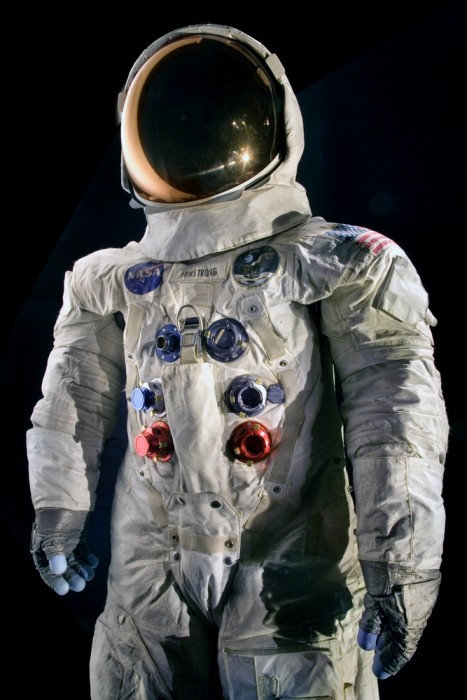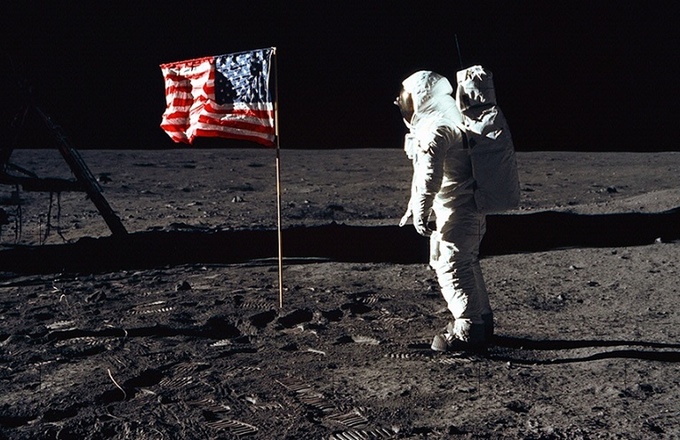Reboot the Suit: Bring back Neil Armstrong’s spacesuit
The Smithsonian’s first ever Kickstarter campaign offers a chance for citizens of Earth to conserve, digitize and display Neil Armstrong’s Apollo 11 spacesuit for explorers everywhere.
Update: Reboot the Suit met its goal of $500,000 in just days. Our next goal is $700,000 to tell the story of the first American in space, Alan Shepard. We plan to conserve, digitize, and display the Mercury suit Shepard wore during the first American manned space flight in 1961. Along with Armstrong’s suit, Shepard’s — and many other suits planned for display in the new gallery – will show the progression of spacesuit technology during the space race era. Keep the momentum going!
July 2019 marks the 50th anniversary of the Apollo 11 Moon landing, a feat so breathtaking in its scope and ambition that it captured the collective imaginations of audiences around the world. The Smithsonian uses the power of real objects to tell stories like this one – stories of the vision, intellect, and courage of men and women who have overcome challenges and pushed boundaries to take the next giant leap for humankind.
The Air and Space Museum is taking its own leap forward to meet the challenge of conserving its iconic collections with the Smithsonian’s first Kickstarter campaign. Kickstarter has crowdfunded more than 88,000 projects, from the mundane to the magnificent, since its founding in 2009. Air and Space is launching its pilot project, Reboot the Suit, with plans to conserve, digitize and display Neil Armstrong’s Apollo 11 spacesuit in time for this milestone anniversary. Conservators will preserve Armstrong’s spacesuit – and the story of its incredible journey – down to the particles of lunar dust that cling to its surface. Just as with the Apollo program itself, this will be accomplished in collaboration of thousands of people across the country and around the world.

This spacesuit was worn by astronaut Neil Armstrong, Commander of the Apollo 11 mission, which landed the first man on the Moon on July 20, 1969.
Federal appropriations provide the foundation of the Smithsonian’s operating budget and support core functions, such as building operations and maintenance, research and safeguarding the collections. Projects like Reboot the Suit aren’t covered by our federal appropriations, which means we can only undertake them if we can fund them some other way. Kickstarter gives a wide audience the chance to be a part of this project.
Surprisingly, spacesuits are among the most fragile artifacts in the Museum’s collection. The Apollo suits were made to take astronauts to the Moon and back safely — not to last hundreds of years in a museum.
Neil Armstrong’s spacesuit – like most of the spacesuits in the museum’s collection – is currently being stored in a climate-controlled collections storage area that is not accessible to the public.
When Neil Armstrong’s space gloves began to develop mysterious spots on the cuff, our specialists took a closer look, and what we found was surprising.
Credit: Video by Smithsonian Channel, Smithsonian Channel HD
To provide public display and access, Armstrong’s spacesuit requires conservation to stop current deterioration and a state-of-the-art display case that will mimic the climate-controlled environment where it is currently being safeguarded. Conservation is the process of documenting, stabilizing and protecting an artifact, not modifying it to make it “like new.” The process takes time. The research and documentation done now will literally write the book on the proper techniques for spacesuit conservation for every suit in our collection. Conservators will be using state-of-the-art techniques in 3D scanning, photogrammetry, chemical analysis, CT scanning and other means available to create a detailed map of the suit that will document its condition in the most complete way possible. This work will inform a condition assessment that will help create the appropriate environment for public display while preserving the suit in its current condition.
3D scanning the Armstrong spacesuit puts the suit directly into visitors’ hands. With a 3D scan of the suit, you can take a self-guided tour and explore the functions of each of the suit’s 21 layers or make a 3D print of Armstrong’s glove and slip it over your hand. Teachers will have a dynamic new tool for talking about the technology required for living and working in space. 3D scanning also ensures that our conservators and curators have an accurate picture of the suit in its current condition, helping to monitor and preserve the suit and protect it from further deterioration.
The Smithsonian’s Digitization team is doing work that will revolutionize the way we interact with and learn from the artifacts in our collection. The team has already scanned a number of the Smithsonian’s iconic artifacts, from the Wright Flyer to the Bell X-1, and is currently in the planning stages to scan the Apollo 11 Command Module Columbia.
Smithsonian X 3D Overview
The suit will be put on display at the Museum in Washington, DC, in time for the 50th anniversary of the Apollo 11 mission in 2019. The suit will eventually be permanently displayed as a centerpiece in the future Destination Moon exhibition, a completely redesigned and updated gallery that will bring the exciting story of lunar exploration to a new generation.
In addition to the Armstrong spacesuit, Destination Moon will feature several other significant artifacts, including a huge Moon mural painted by the famous space artist Chesley Bonestell in 1957, the Freedom 7 Mercury capsule in which Alan Shepard became the first American in space, the Gemini 7 spacecraft, the giant F-1 rocket engine, the Apollo 11 Command ModuleColumbia, parts of the Apollo Mission Simulator, and many small artifacts. The exhibition will also display the Ranger, Surveyor, and Lunar Orbiter spacecraft currently hanging elsewhere in the Museum, and at least one other robotic spacecraft from a more recent mission.

Lisa Young, objects conservator at the National Air and Space Museum, works on Neil Armstrong’s Apollo 11 spacesuit in the Emil Buehler Conservation Laboratory. (Photo by Dane Penland)
The Apollo 11 Moon landing was one of the single greatest achievements in the history of humankind. Bringing Armstrong’s spacesuit back not only helps honor the accomplishments of a generation who brought us from Earth to the Moon in less than nine years, it also inspires the next generation of bold space explorers.
The suit is a part of our cultural heritage, and safeguarding it recognizes its importance in telling the story of a remarkable accomplishment. And because it is the real thing, seeing the suit provides a tangible way of touching history. Join the Kickstarter campaign and be part of history.

Astronaut Buzz Aldrin poses for a photograph beside the deployed United States flag during an Apollo 11 Extravehicular Activity (EVA) on the lunar surface. Astronaut Neil Armstrong, commander, took this picture with a 70mm Hasselblad lunar surface camera.
Posted: 21 July 2015
-
Categories:
Air and Space Museum , Feature Stories , News & Announcements , Science and Nature




